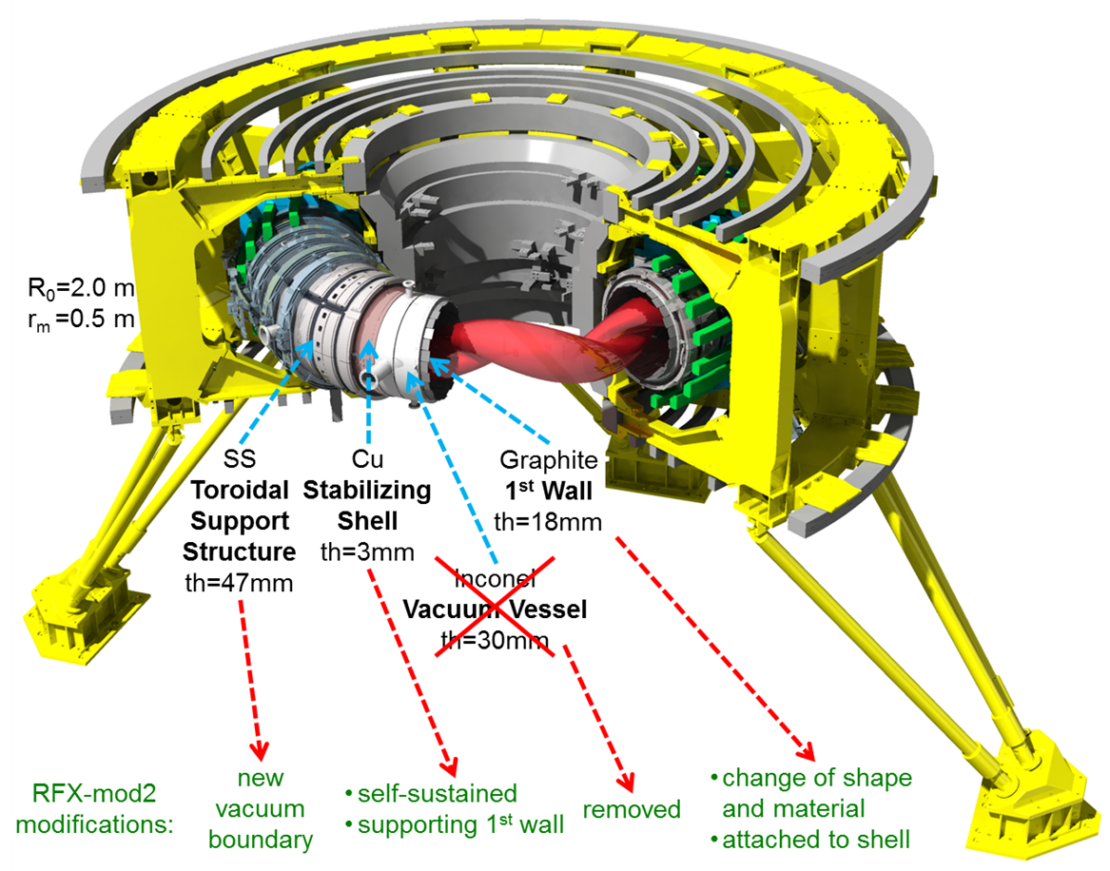The evolution of the RFX experiment
RFX, RFX-mod, and RFX-mod2 are the names that have marked the evolution over time of the largest experiment for the study of plasma physics in the Reversed Field Pinch (RFP) magnetic configuration. It started with RFX, which achieved its first plasma in 1997, progressed to RFX-mod operational between 2004-2016, and now RFX-mod2 is in an advanced stage of upgrade.
Both in RFX and in RFX-mod, the plasma was contained in a series of concentric layers of conductive material. In RFX, plasma stability was ensured by a thick (5 cm) aluminum shell, which was replaced in RFX-mod by a steel shell (a material much less conductive than aluminum) that supported 192 control coils with a thin inner copper shell.
In both experiments, the plasma was then contained by an inner vacuum chamber made of Inconel, a special alloy with low conductivity, which tended to slow down plasma instabilities while simultaneously increasing the localized interaction of the plasma with the first wall: the unstable modes interacted with each other and with the chamber wall, causing a “locked” deformation of the magnetic field.
Upgrades from RFX-mod to RFX-mod2
The RFX-mod2 machine aims to complete the study of the properties of the RFP configuration in the plasma current regimes up to 2MA.
To this end, modifications of some components of the RFX-mod machine are underway.
In RFX-mod2, the vacuum chamber will be removed, and the plasma will be directly surrounded by the copper shell (protected by 2016 graphite tiles). This increase in the conductivity of the first conductive material surrounding the plasma will allow us to observe plasmas without stationary localized interaction, even at high current regimes.

From RFX-mod to RFX-mod2: the modifications underway

We expect that this will enable us to produce better-confined plasmas with more stationary helical states. It should be emphasized that these results will be very important for understanding whether the RFP configuration can indeed have potential as a future reactor.
The purpose of these changes is twofold
While the RFX and RFX-mod experiments were surrounded by a vacuum chamber characterized by a very high resistivity (Inconel 625), in RFX-mod2 a copper structure, of much lower resistivity, will be the conductive surface closest to the plasma. It will be protected by a wall made of graphite tiles, which is the first material surface seen by the plasma and built to withstand its power.
Thanks to these modifications,
Several advantages are expected
RFX is a device included among the High Priority R&D Infrastructures in the National Research Program 2021-2027 in the Energy sector
The upgrades were financed by the Veneto Region under the 2014 – 2020 Por/Fesr research grants. The MIAIVO project, obtained in collaboration with the Industrial District of the upper Vicenza area, has brought in 2 million Euros of funding for research and development, slightly less than the half of the expected expense for completing all the upgrades.
RFX-mod2 have also obtained funds within the PNRR Nefertari Project of which CNR-ISTP is the proposer, along with the University of Padova and the University of Naples Federico II. New diagnostic systems and renewed facilities, will significantly improve RFX-mod2’s capacity to explore the potential of the RFP configuration as an alternative to the Tokamak configuration and to contribute to specific aspects of Tokamaks.